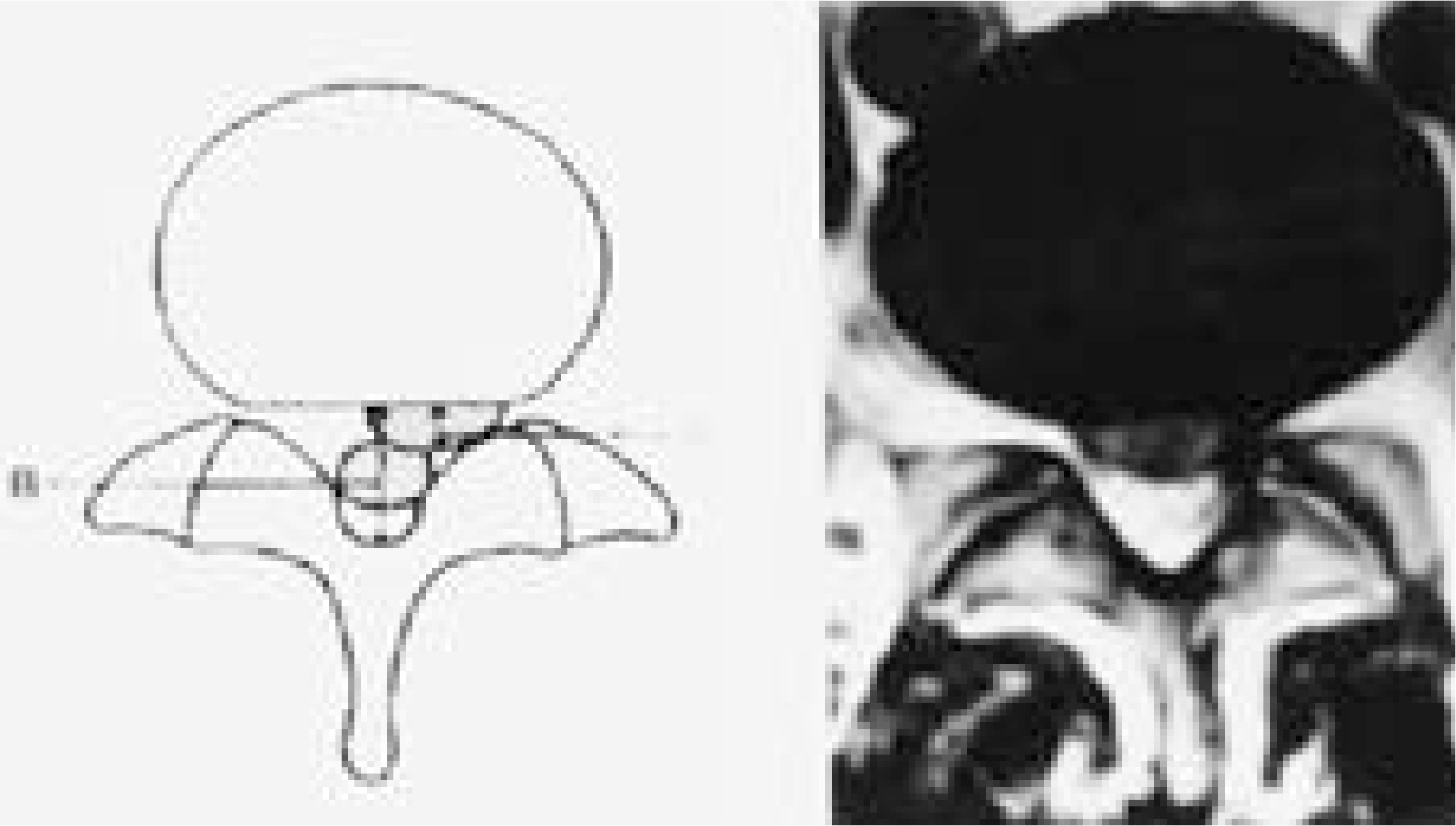J Korean Soc Spine Surg.
2002 Mar;9(1):14-18. 10.4184/jkss.2002.9.1.14.
Significance of Space-Occupying Ratio According to MRI Finding in Lumbar Disc Herniation
- Affiliations
-
- 1Department of Orthopaedic Surgery, College of Medicine, Dong-A University, Busan, Korea. gylee@mail.donga.ac.kr
- KMID: 1897085
- DOI: http://doi.org/10.4184/jkss.2002.9.1.14
Abstract
-
STUDY DESIGN: Clinical significance of space-occupying ratio according to MRI finding in lumbar disc herniation.
OBJECTIVES
To estimate relationship between patient's symptoms and space-occupying ratio in herniated lumbar vertebral disc in MRI according to JOA scoring system. SUMMARY OF LITERATURE REVIEW: Using MRI, herniated intervertebral disc may be estimated with the extent of derangement of the constituents of the disc. Symptoms and signs did not correlate with the degree of reduction of the herniation in MRI. MATERIAL AND METHOD: A retrospective analysis was performed upon 99 patients that underwent lumbar spine MRI. The degree of the occupied spinal canal was measured by 'Space-occupying ratio', which was the ratio of the longitudinal diameter at the spinal canal to the longitudinal diameter at the herniated nucleus purposus. Each '30% Space-occupying ratio' to '50% Space-occupying ratio' was classified to analysis I, analysis II. Under the percent was group A, above the percent was group B. We estimate the patient's condition related with lower back pain according to JOA scoring system.
RESULTS
The herniation type of the nucleus purposus was classified to 5 protruded type, 62 subligamentous extruded type, 22 transligamentous extruded type, 10 sequestral type. The patients who have above 30% were 62 cases, under 30% were 26 cases in analysis I, have above 50% were 19 cases, under 50% were 69 cases in analysis II. So, there was not distinguished from analysis I to analysis II according to the degree of the herniation. Mean JOA score was 9.307 in group A, mean JOA score was 9.370 in group B in analysis I. Mean JOA score was 9.391 in group A, mean JOA score was 9.315 in group B in analysis II. There was not correlate statistically with analysis I (p value=0.5669) and analysis II(p value=0.5390) using the Wilcoxon score test.
CONCLUSION
There was not correlate statistically with the degree of the herniation in lumbar spine MRI according to JOA scoring system.
Keyword
MeSH Terms
Figure
Reference
-
1). Ahn SH, Ahn MW, Byun WM. Effect fo the Transligamentous Extension of Lumbar Disc Herniation on Their Regression and the Clinical Outcome of Sciatica.:Spine. 25:475–480. 2000.2). Gertzbein S. Degenerative disc disease of the lumbar spine.:Clin Orthop. 129:68–71. 1997.3). Fawzy AA, Dobrow R, Franson RC. Modulation of phospholipase A2 activity in human synovial fluid by cations.:Inflammation. 11:389–400. 1987.4). Kim KY, et al. .:. Magnetic resonance imaging in the evaluation of the lumbar herniated intervertebral disc. International Orthopaedics(SICOT). 17:241–244. 1993.
Article5). Marshall L, Trethewei E, Curtain C. Chemical radi -culitis: Clin Orthop. 129:61–67. 1997.
Article6). Marshall L, Trethewei E, Curtain C. Chemical irritation of nerve-root in disc prolapse: Lancet ji. 7824:320. 1973.7). Mitsuo Hasue, Masatoshi Fujiwara. Epidemiologic and Clinical Studies of Long-Term Prognosis of Low-Back Pain and Sciatica.:Spine. 4:150–155. 1979.8). Pruzanski W, et al. .:. Phospholipase A2 activity in sera and synovial fluids in rheumatoid arthritis and osteoarthritis: J Rheumatol. 12:211–216. 1985.9). R.D. Fraser, et al. .:. Magnetic Resonance Imaging Findings 10 Years After Treatment for Lumbar Disc Herniation.: Spine. 20:710–714. 1995.10). Saal and Saal. Nonoperative Treatment of Herniated Lumbar Intervertebral Disc with Radiculopathy. An Outcome Study.:Spine. 14:431–437. 1989.11). Saal , et al. .:. High Levels of Inflammatory Phospholipase A2 Activity in Lumbar Disc Herniations.:Spine. 15:674–678. 1990.12). S.D. Boden, et al. .:. Abnormal Magnetic-Resonance Scans of the Lumbar Spine in Asymtomatic Subjects: JBJS. 72-A:403–408. 1990.13). Suk SI, et al. .:. Orthopaedics:. 14:1999.14). Takura K, et al. .:. Swelling of the cauda equina in patients who have herniation of a lumbar disc.:JBJS. 70A:361–368. 1988.15). Y. Matsubara, et al. Serial changes on MRI in lumbar disc herniations treated conservatively. Neuroradiology. 37:378–383. 1995.
Article16). Yorimitsu , et al. Long-Term Outcomes of Standard Discectomy. Spine. 26:652–657. 2001.
- Full Text Links
- Actions
-
Cited
- CITED
-
- Close
- Share
- Similar articles
-
- The Influence of the Degree of Lumbar Disc Degeneration on MRI and the Amount of Removed Disc on Clinical Outcomes
- The Spinal Extradural Meningeal Cyst Associated with High Disc Lumbar Herniation: Case Report
- Clinical Analysis of Recurrent Lumbar Disc Herniation
- Intradural Disc Herniation at L5-S1 Mimicking an Intradural Extramedullary Spinal Tumor: A Case Report
- A radiological study on lumbar disc herniation in Korean


